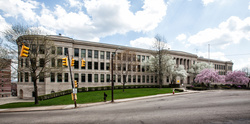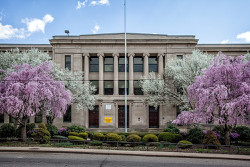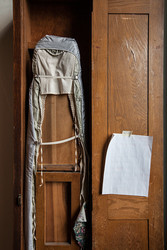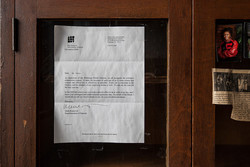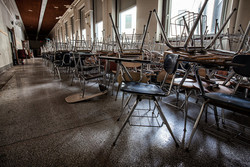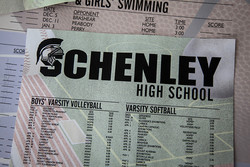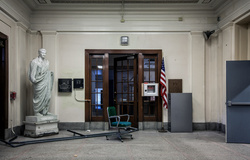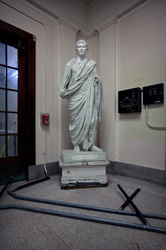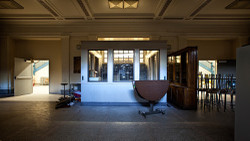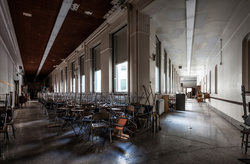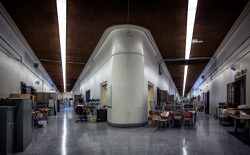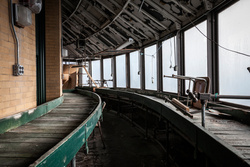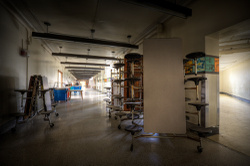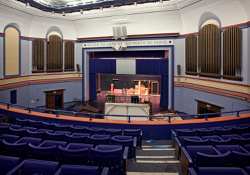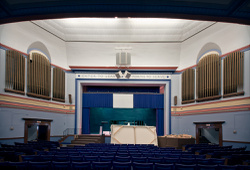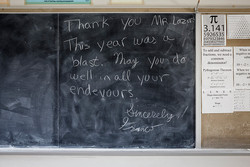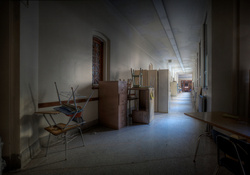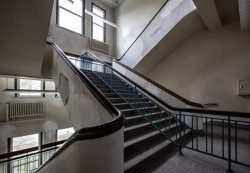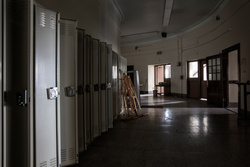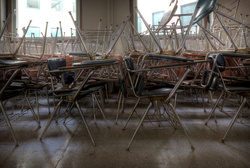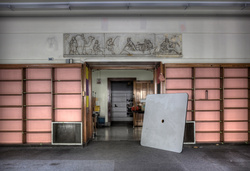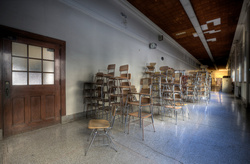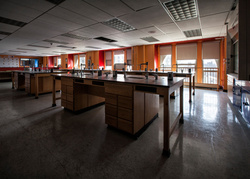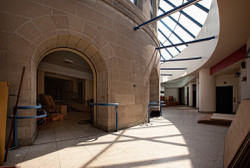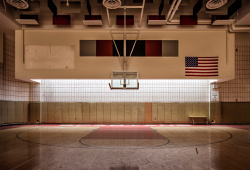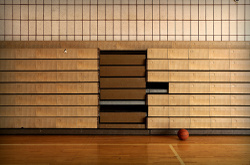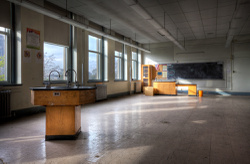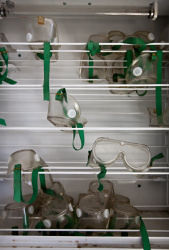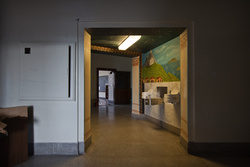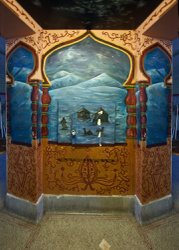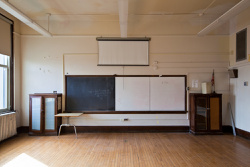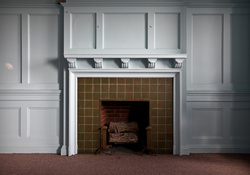Schenley High School
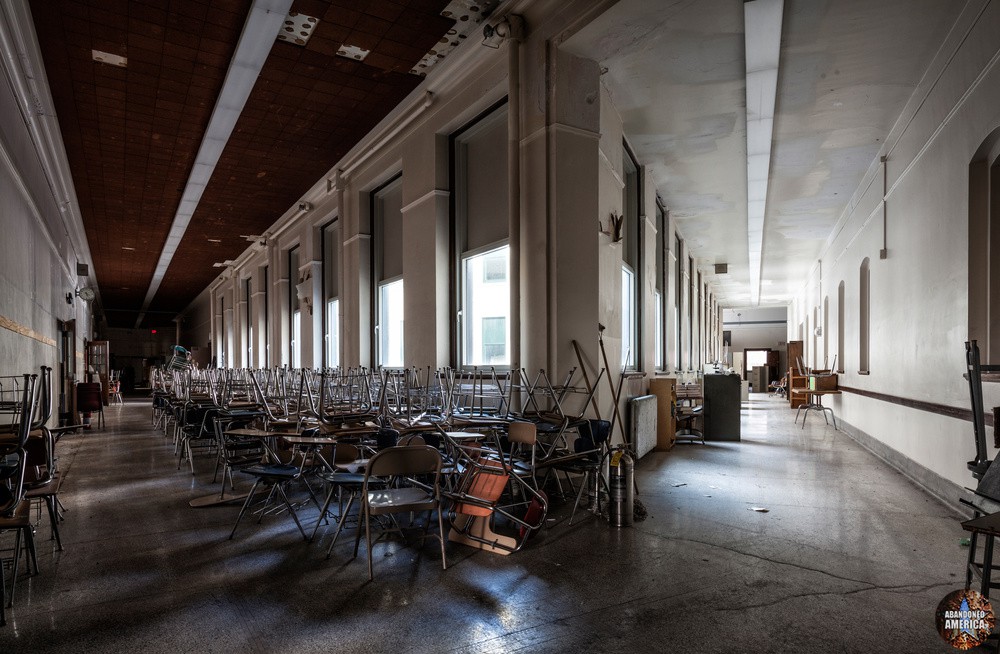
A uniquely designed hallway at Pittsburgh's abandoned Schenley High School
Updated June 16, 2022 | By Matthew Christopher
Perhaps of all the abandoned sites I’ve visited, the most disheartening are schools. When I visited Schenley High School in Pittsburgh in 2010, it was only two years after its closure in 2008, and the signs of the magnitude of its loss were everywhere. Goodbyes were written to the school and its faculty on chalkboards, murals that students had painted were around every corner, and the beauty of the structure itself was impossible to ignore. Schenley wasn’t just any high school, it had actually been the first public school to cost over $1 million and represented a huge investment by the city of Pittsburgh in its school system. It was hard to fathom why it would be closed, particularly when it seemed to be in such good condition overall. The representative of the school district who granted access to me noted that the asbestos in the walls and ceiling was too costly to abate and that no work could be done to update the building without removing it first. The pool and gym, added in 1988 as part of a $9.4 million addition, looked brand new and the auditorium had recently also received a renovation costing $750,000. Nevertheless, the fate of the building seemed certain: without the money to repair it, the school district had little choice but to close it permanently. Mere blocks from some of the best universities and museums the city had to offer, the triangular monument to public education that had once been dubbed “The Pride of Pittsburgh” would no longer be a school, but what was to come next for it was uncertain.
In the middle of the 19th century, education was predominately a luxury of the wealthy. While many of the original states did have varying provisions for education, schools were often extensions of the church and no federal standards existed. Reformers like Horace Mann and Henry Barnard argued that schooling prevented crime and poverty, creating better citizens - and thanks to their efforts, a public educational system on the elementary level was established. It was not until the early 20th century that high schools rose to prominence, and when they were created and mandatory attendance was established the concept was still controversial and progressive. The effect was profound; in 1900 only 6 percent of the population graduated from high school, whereas in 2000 it had risen to 68 percent.
In the early 20th century, the Pennsylvania school system had just been reorganized; central school boards now held the power to design bigger and better schools, and Schenley was to be the first test of this new authority. Plans were in the works for Schenley’s construction years before it opened, and the fierce arguments that marked its closure were also present in its planning phases. Noted Pittsburgh philanthropist Mary Schenley had donated the land for the school, but the cost of the proposed building was an issue early on. There were some concerns that the site rested on quicksand and water, but these fears were allayed by building the school on a network of 1,700 piles, some as deep as 40 feet; this would earn the school the nickname “the high school on stilts”. Area architect Edward Stotz was chosen (through more heated debates) to design the building. Later in his life he would refer to Schenley as the most beautiful of all his works.
Construction began in 1914, and while it was held up with labor and contract disputes and the death of a stone setter who fell five stories in 1915, the school was finished in 1916. The façade was made of Indiana limestone, hallways floors were terrazzo, the stairs were white marble, and the school’s own power plant provided electricity to all of the rooms. A statewide quarantine for infantile paralysis delayed the opening by a month, but on October 2, 1916 70 teachers and the first class of 1,800 students entered their new home.

A postcard of Schenley High School dates 1930
Schenley High School was magnificent, and the city’s newspapers heralded it as the ‘last word in educational institutions’. The Pittsburgh Daily Post crowed, “There are 180 rooms in the structure, including 40 class rooms, 11 laboratories, 11 shops, four crafts rooms, seven domestic science rooms, two music rooms, a library, six commercial and accessory rooms. There is a swimming pool and 33 shower baths, separate gymnasiums, fully equipped, for boys and girls; a suite of offices and a master clock controlling the time in 27 clocks in the building; complete medical inspection equipments, with rooms, and… Two lunch rooms, including their own separate cooking facilities, will feed 1,800 students, boys and girls separated, in 30 minutes, on the cafeteria plan.” The Pittsburgh Sunday Post added, “There is an auditorium that is virtually a modern theater, with seating capacity of 1,550 and equipped with a 30-foot lantern screen upon which educational films will be shown, and on the first floor is an office with the inscription, “School Mother,” upon its door. The “school mother” is a woman to whom the pupils may go with their troubles for advice or comfort.” An even mile of hallways were lined with replicas of famous artworks, and the student’s society room on the second floor could seat 150. “May all the users of this school appreciate what the taxpayers have done for them,” the Sunday Post exclaimed. The cost of the school had been roughly $1.5 million; at the time it was the most expensive school ever built.
To say that the community was also proud of the school would be an understatement; lauding it as ‘symbol of Pittsburgh’s progress”, private donors raised funds to outfit the auditorium with a pipe organ from highly esteemed Skinner Organ Company in the early 1920s. The Morning News in Danville, Pennsylvania wrote of “the progress of high schools which are, comparatively speaking, one of the more recent educational institutions”, lauding the Pittsburgh school district’s broad array of academic and vocational courses, which included “astronomy, archery, journalism, drama, cabinet making, jewelry making, forestry, nursing stamp and coin collecting chess [sic], banking, photography, etiquette, and a long list of others.” At Schenley, even the relatively new pipe organ was featured in a course.
Schenley’s reputation as a bastion of academic excellence continued for decades, and it produced a number of notable alumni such as Andy Warhol, Nobel-prize winning physicist Clifford Shull, Harvard Law School’s first African American professor Derrick Bell, a number of well known professional athletes, and several notable musicians such as jazz guitarist George Benson. By the 1970s and early 80s, however, it was one of the lowest performing schools in Pittsburgh. While Schenley students were winning many city and state championships, it was clear that something had to be done. The novel solution was to rebrand the school as the Schenley High School Teacher Center and cycle all of the districts educators through Schenley to update their methods. The plan worked: Schenley leapt from the second worst to the second best school in Pittsburgh and was a model for the district once again. When Jesse Jackson visited the school he compared the school’s diversity to the United Nations. James Hill, a Schenley alumnus who has taken on the mantle of collecting the school’s history and memorabilia after the closure, called this the school’s great comeback story: “Schenley defines sort of a classic American turnaround story... How it went from its lowest point to its highest and through all the things in between was by still holding its character.”
Hill, who now works as special assistant to the mayor of Pittsburgh, was a student in the class of 2011 - the last to graduate with diplomas from Schenley. The school had actually closed in 2008, however, after Hill’s first year of attendance, and the students were shuffled off to another closed school, Reizenstein. It was a hugely controversial move that angered many in the community and continues to be a source of debate to this day.

A stairway in Schenley High School shows evidence of the issues with plaster caused by humidity in the building
Two things happened in 2002 that would eventually lead to the closure of the school. The first was a project to remove the aging wooden windows with newer, modern ones. The ventilation system, which had been revolutionary when it was created, hadn’t been operational for decades, and the new windows sealed the building too well; with no air flow, the heat and humidity in the school created problems with the paint and plaster. The second event was a commissioned study of the plaster by AGX Inc., which reported “numerous wall and ceiling plaster samples were asbestos containing, with results ranging from 2% to 7% Chrysotile asbestos.” Chrysotile (or white asbestos) is a mineral popular in construction due to its properties as an insulator and fire retardant, and it makes up approximately 95% of the asbestos used in buildings in the United States. In the second half of the 20th century another unfortunate property of asbestos came to light: when disturbed, the fibers can become airborne, and when inhaled they can cause several types of cancer and scarring of the lungs. If the percentage in plaster is less than 1%, or remains undisturbed, it is not considered a problem. This was not the case at Schenley. Of the 406 samples AGX collected from plaster, tiles, and the ceilings, they found 277 that contained asbestos.
“The big issue that came from the district,” Hill says, “was that they needed to replace mechanical systems. The air system needed to be replaced and then it became, ‘while we’re replacing the air system, you know we might as well replace the electrical system.’ ‘While we’re replacing the electrical system, we might as well redo the plumbing.’ And the whole core of it was that there may or may not have been asbestos in the walls, which would prohibit them from doing so.” A 2006 estimate listed the cost for asbestos abatement at nearly $56 million and nearly $87 million for the electrical systems. Another said it would be $32 million to take care of the major problems and $62 for a full renovation. The Pittsburgh Post Gazette uneasily opined, “Here's hoping the committee sees the school for what it is: a tremendous asset in which taxpayers have made a hefty economic investment, $1.48 million for the land, building and equipment, and another $9.4 million for the 1985 addition, which added a new pool and a gymnasium. That's a total of more than $43 million in 2006 dollars, a fraction of what it would cost to assemble the land and erect such a building in that neighborhood today. But thanks to the foresight of an earlier Board of Education, it's already there. All this one has to do is take care of it.”
In 2007, the problems with the plaster, which the humidity in the building had loosened, were becoming too great to ignore. In July there were two incidents with falling plaster, the second of which led to the relocation of summer school classes and a plaster abatement project over the summer. In September 7, a 12 square foot section of delaminating plaster in a stairwell required an abatement, and over the holiday less than a week later a steam leak in a cluster of decayed pipes caused part of another plaster ceiling to fall. Mark Roosevelt, the Superintendent of Pittsburgh Public Schools, was quoted by the Tribune-Review as saying, “Every decision I make is based on the question: 'Would this be right for my child?’” In the same article, Vidya Patil, the acting director of facilities related friction in his family over the push to close the school. His 16-year-old daughter was a junior at Schenley and wanted to keep the building open. “I'm very concerned about the deteriorating condition in the building -- particularly the asbestos," Patil told the Tribune-Review. "The amount of monitoring and dollars it takes to keep it safe is almost unbearable."
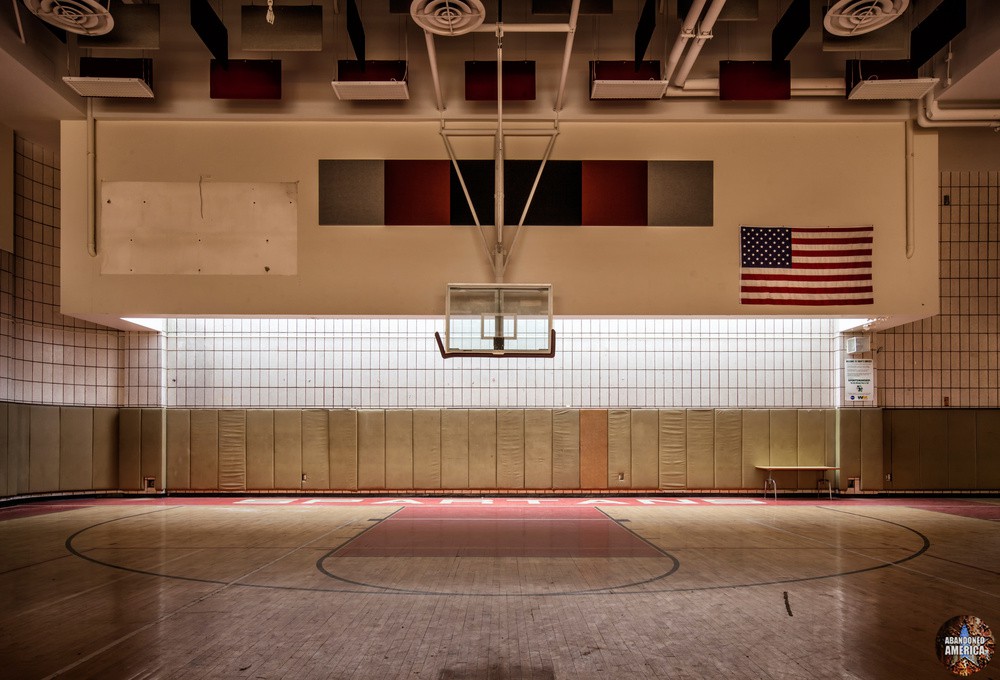
Schenley High School's auditorium, constructed just before the school was closed
Part of the issue was that the Pittsburgh School Districts were in dire financial straits. A $72 million operating deficit and lower school enrollment led to a “right-sizing” plan that closed 22 schools that year. Needless to say, it was not a plan that was popular with families in the district. “Schools normally don’t close when they’re high achieving, diverse schools. In 2007, Schenley had it’s fifth state basketball championship. Five is the most of any public school in the state, as far as I know,” Hill told me. “It was still the second highest performing school in the district at that time. It was a school that truly had a very deep stake in the community, and it was a school that people truly rallied behind.” Nonetheless, the school district voted to close Schenley to avoid the renovation bill in 2008 by a 5-4 vote. Hill describes his first and last year at Schenley High School as surreal. “Everything had such a final feel. The senior class of 2008 had a beautiful ceremony where they threw 92 roses on the front steps for every year that the school had been open at that point.” There was a sense of sorrow and disbelief among the students and faculty. “Everything we did was going to be the last of something.”
After the school closed, the process of moving equipment and other assets out of the building began, and another more comprehensive asbestos and hazardous materials assessment was conducted by Richard Kimball & Associates, Inc. While the report stated, “Based on a recent review of the facility, it was the recommendation of Kimball that the district not continue to occupy this facility due to de-laminating plaster and the potential of environmentally hazardous materials without performing significant remediation, repairs, and alterations to the facility,” they found that of 476 samples of plaster and other building material, only two taken in the auditorium contained greater than 1% asbestos. The testing methods used by Kimball were more thorough and accurate, yet the district continued to use the earlier report as the basis for its strategy moving forward, though the reasons why are unclear.
In 2013 the current Superintendant, Linda Lane, said in a school district press release “We understand why the alumni of Schenley High School have such a great passion for the school. While we too love the beautiful Schenley facility and wish we could afford the renovations necessary to maintain the landmark building, we must balance the need to resolve a very concerning financial future in the context of our the [sic] need to accelerate the academic achievement of all students.” Shortly after, Schenley was sold despite fierce protests to a developer who planned to convert it to luxury apartments for $5.2 million. Their cost to completely gut and renovate the building for an entirely different purpose was substantially less than the amount the school district was quoting for their own costs just to maintain it.
Hill feels the constant renaming and relocation of students in district schools erases the names of the philanthropists who helped build the city and also has created a disconnect among students with the buildings they study in. “When you succeeded, you did it for yourself, but you also did it for Schenley. You did it for the pride of the school. I think we’ve really lost that. Kids don’t do it for the pride of their school anymore, because there’s no history to be proud of.” The budget problems continue in the Pittsburgh School District; according to a 2014 article in the Pittsburgh Business Times they are due to “declining enrollment, a reduction in federal and state funds, growing pension costs and increasing tuition payments for students that attend charter schools.” A year later, Mareesa Nicosia wrote in The Atlantic, “Pennsylvania public schools are now at Defcon 1—borrowing millions of dollars to keep the lights on, starting to ask teachers to work without pay, and even voting to shut the schoolhouse doors and send the kids home—all because an unprecedented state budget crisis has left them within weeks of insolvency… Many Pennsylvania districts, still recovering from the recession and a massive 2011 state-aid cut, were already financially vulnerable.”
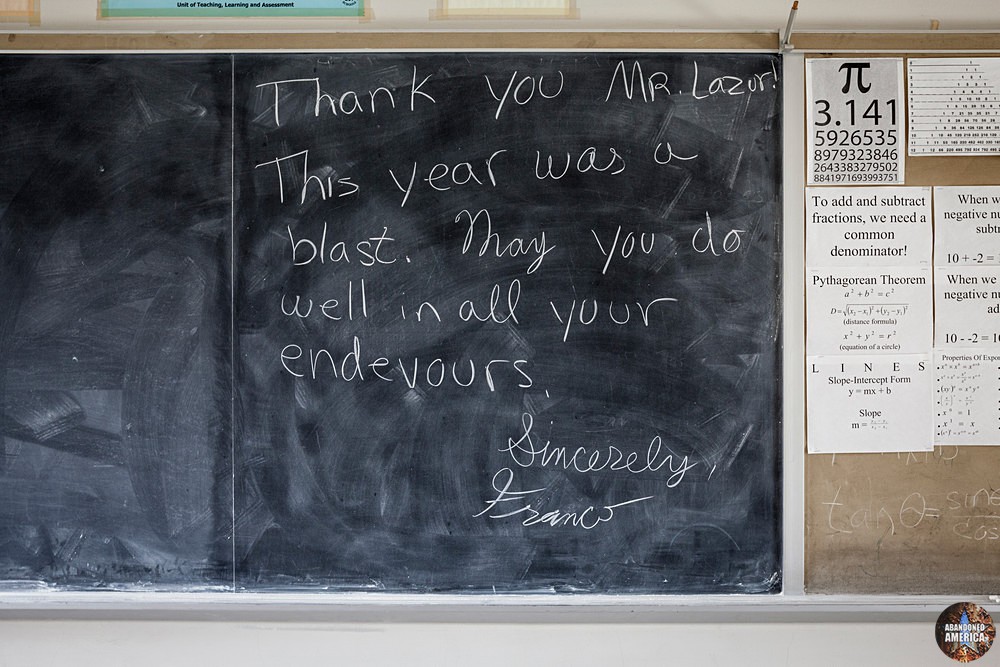
A goodbye from a student to a teacher written on one of Schenley High School's chalk boards
For its part, Hill characterizes Schenley’s developer as receptive and agreeable to ideas such as including historical photos in public areas of the renovated building. 2016 marks the building’s “Schentennial”, and Hill and other alumni are working on having a “Schendig” to celebrate. When I asked him what lesson he took away from the closure that he wanted to share with others, he thought for a moment and replied, “I’d just say, look around at the things that the people in the past built for us. I can only imagine that a lot of people went through that building without ever truly getting to appreciate the majesty of 20-something foot ceilings, and spectacular organs, statues of Caesar, Greek friezes in the halls. I think it’s the best example of how you really don’t know what you’re missing until it’s gone. So just look around this world of architecture and appreciate the things that people have built for us, because there’ll be a day when something that you always thought would be there – and seemed immovable – will not be what it was anymore.”
In parting, I also asked Hill what his favorite memory of Schenley was, and it really struck me as one of those anecdotes that somehow encapsulates the spirit of the building’s entire lifespan. “I’ll just never forget my first day as a student at Schenley,” Hill said. “Like any kid, at that point I was like ‘oh god… middle school… I miss my friends... is everybody gonna hate me at this new school?’ It was just a beautiful summer afternoon, we had a book that we were reading and we went out on the front steps to read them. I remember looking around, and seeing this magnificent limestone building – at that point it was still extremely well cared for, so all the flowers were in bloom, all of the magnolia trees were spilling their purple leaves down upon the kids – and I realized, high school’s going to be okay.”
Schenley High School is a chapter in my book, Abandoned America: Dismantling the Dream.
Buy a signed copy via this link or get it on Amazon using the link below to read more!
Listen to the new Abandoned America podcast here!
Join us on Patreon for high quality photos, ad-free exclusive content, and book previews
